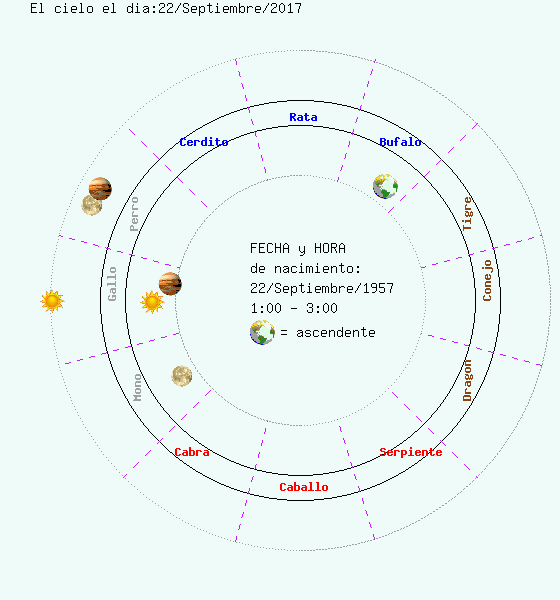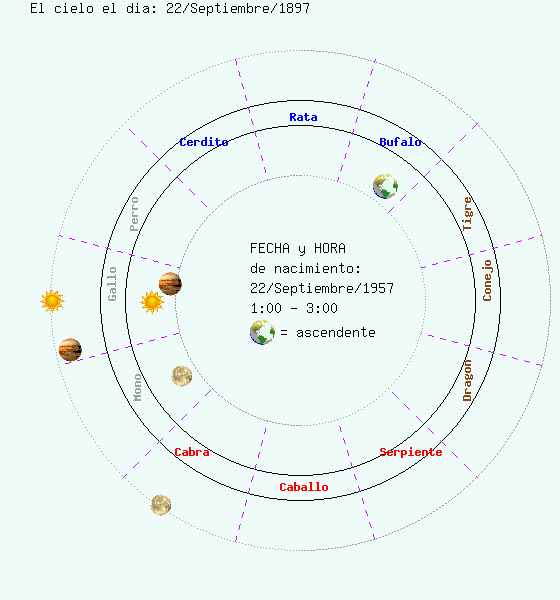Since some years ago, many people feel that the influence from the next year's chinese sign is felt much earlier than expected, that is, not from January/February but a few months earlier, in the autumn in the Northern Hemisphere.
Obviously this is a just a feeling, something you can't check with a "scientific instrument"; you could say that somebody is of Asian or European origin because of his/her face, but saying that someone has characteristics of a rooster instead of a monkey is basically a subjective opinion.
However, there are several objective facts that support this feeling about the influences of the chinese yearly signs being noticed increasingly early, and so I decided to show them here to share them with people interested in the matter.
The key question is: ¿why 2017 will be the year of the Fire Rooster?
The answer is simple: because that's the year that follows the Fire Monkey year according to the Chinese Lunar Calendar, in the same way that it will be the year 2017 because it follows the year 2016.
The problem is that the "Chinese Calendar" is not the same thing as "Chinese Astrology, the first just counts time, the second tell us about the Heavenly influences over Earth across time, and as incredible as it may seem, the official response of most chinese astrologers is that it will be the Fire Rooster year simply because it comes after the Fire Monkey year.
In other words, there is no astronomical ephemeris that justifies the sign of the year in Chinese Astrology, but on the other hand, the chinese sign of the month depends on the relative position of the Sun over the different areas of the Sky, and in the same way, the sign of the hour (ascendant) depends on the sun's position in relation to the birthplace.
However, considering that there are 12 chinese yearly signs, and that Jupiter takes almost 12 years to complete his orbit around the Sun, one might think that it's the position of Jupiter in Heaven what determines the influence of the so-called chinese year sign, even if this is against the official accepted wisdom of present chinese astrology.
Surprisingly enough, this idea of being Jupiter who defines the yearly influence of the 12 chinese signs finds several facts that support it:
- During the last 100 years or so, the position of Jupiter in the Sky for every year has mostly coincided with the area belonging to the 12 chinese signs as defined by the chinese solar months.
This may seem confusing, but is easy to understand with this graphic obtained with this program:

In the above image, the inside circle represents the positions of the Sun and Jupiter the 22th of September of 1957 (the past year of the Fire Rooster), as you can see both the Sun and Jupiter are in the area of the rooster.
Then, in the following year of the Fire Rooster (2017), on September 22, in the outer circle we can see the Sun will be again in the area of the Rooster, but Jupiter will be a little bit forward, actually in the Dog's area.
This happens because of Jupiter Cycle, which does not take 12 years to go around the sun, but 11.86 years, so 60 years later it is not in the same place, but a little bit more forward.
- This situation in which the position of Jupiter in the Sky coincides with the yearly names of the chinese signs as defined by the chinese astrological months happens only once every 1000 years or so, last time it happened before 1957 was in the year 937:

- Since year 937 until 1897 didn't match again, so in the 15 years of the Fire Rooster between years 937 and 1957, Jupiter was outside of the area of the Rooster as defined by the chinese astrological months.
In fact, according to this theory, in the late nineteenth century, the influence of the chinese yearly sign would have being felt later than expected, because as can be seen in this graph, in September 1897 Jupiter had just entered the Rooster area, even though the Chinese year of the Fire Rooster had begun 8 months before according to the Chinese Calendar:

- Apart from this, it was in the Tenth Century of our era that the 12 Chinese signs became popular in China and began to be associated with the corresponding years of the Chinese Calendar, which was already in use since several thousands years ago, but without the names of the 12 animal signs.
In fact, one of the oldest representations of the 12 chinese zodiac signs in China, as far as I know, is in a calendar that appears in the manuscript called "Tun Huang" from the year 978, click over the image to see it in detail:

The 12 animal signs are represented over the heads of the 12 men around the table, the image quality is no good at all, so it's hard to see it.
And at least to me, it seems too much of a coincidence that the Chinese began to name their years with the 12 animal signs that we know today just when the positions of Jupiter matched with their associated areas in the Sky.
My guess is that they may have done so because empirically they saw that the influences of the 12 signs were felt in their corresponding years (during the tenth century).
- Also, during the years when Jupiter's position coincided with the chinese solar months (early X century), China was in a very chaotic period of its history, the Tang dinasty having collapsed in year 906 and the situation wouldn't stabilize again until well past 960/978 when the Song Dinasty became well established.
So one may think that in this chaotic environment it was much easier for the Chinese Calendar to change in the sense of including the 12 animal signs to name the years, it may have been a way for the new rulers to mark a difference with the past, specially if there was a popular belief in the relation between the Chinese Calendar years and the 12 animal signs cycle.
- Talking about chaotic periods of China, there is a surprising astrological parallelism between the transition from Tang Dinasty to Song Dinasty, years 906-978, and the transition from Manchu Dinasty, 1900/1911, to the current People's Republic of China, well established since 1949, but taking into account the "Great Leap Forward" and the "Cultural Revolution", it seems that things just got stable again after early seventies of XX century.
- And if this was not enough coincidence, the situation in Korea in those very same periods was also quite chaotic, as it was in 935 that general Wang Kon toppled the local korean governments (Silla, Koguryo e Paekche) and unified the country (by means of war). Then in 1910 the Japanese invaded Korea, and the war and very hard situations lasted until last quarter of XX century.
- But astrological parallelisms appart, after the tenth century, it could be that the Chinese would continue naming their years with the names of the 12 signs simply out of habit, even if it wasn't so clear anymore that their astrological influences were those associated with each sign; it would be interesting to investigate if during XIX century in China people was as fond of naming the Chinese Calendars years with the 12 zodiac names as it's today, or maybe that custom revived since early XX century.
- Also coincidentally, in the early twentieth century when Jupiter's position began to match again with the signs of the Chinese Calendar, there was a renewed faith in Chinese Astrology in the Western World.
- This theory is also supported by the fact that chinese natal charts between the tenth and nineteenth centuries do not use the animal sign of the Chinese Calendar as an important figure, but instead they use many other astronomical data.
- On the other hand, there is abundant evidence that the Chinese Signs we know today were not a chinese invention, but came from a neighboring country, one of the oldest known representations of them being in a tomb of the eighth century in Silla (Korea), and there are theories that their origin may be from Mongolia, India or even Turkey.
This suggests that before using the 12 signs to name the years of the Chinese Calendar, they could have been used in another way, perhaps associated with the different positions of Jupiter in its almost-12-year cycle.
- What is clear is that long before the 12 animal signs were invented, chinese astrologers used the position of Jupiter in the sky to refer to the influences of the year, without mixing this with the Chinese Calendar.
For example, in the story of Du Lanxiang of the first century AD (Han Dynasty), the story revolves around a girl, who was a brilliant astrologer, who said that she had to wait until "the year that Jupiter is in the East" to marry her boyfriend so the marriage would be successful; this means that long before the 12 chinese signs were invented, it was common to look at the influence of the year by the position of Jupiter in the sky, which the current chinese astrology (BaZi) doesn't do.
Of course, it isn't a simple issue, but the basic idea is that the astrological influence of the chinese yearly signs doesn't depend on the Chinese Calendar, but on the position of Jupiter in the Sky
And because Jupiter's cycle lasts almost 12 years, one century in one millennium the names of the Chinese Calendar years matches those of the areas of the Sky were Jupiter is, that happened in the X century and during the XX century, but not in the XXI century.
However, there are some missing pieces in this theory, because although it is true that the influences of the next chinese year sign are felt earlier than expected (perhaps from October), if you just consider the Jupiter position, the influences should be felt even much earlier, about 4 or 5 months, maybe around may.
According to my observations, it seems that there is a lag of about 13 degrees between the position of Jupiter and the influences felt because of it, I think that maybe it's due to the combination of its magnetic field with the magnetic deviation on Earth, or maybe it's related to Jupiter's apparent retrograde motion due to the movement of the Earth around the Sun.
So as I hadn't clear all of the details of this theory I didn't publish it before, but as it was time to write the 2017 predictions I was forced to write about this, otherwise I couldn't make these predictions consistent with what experience tells me that works.

